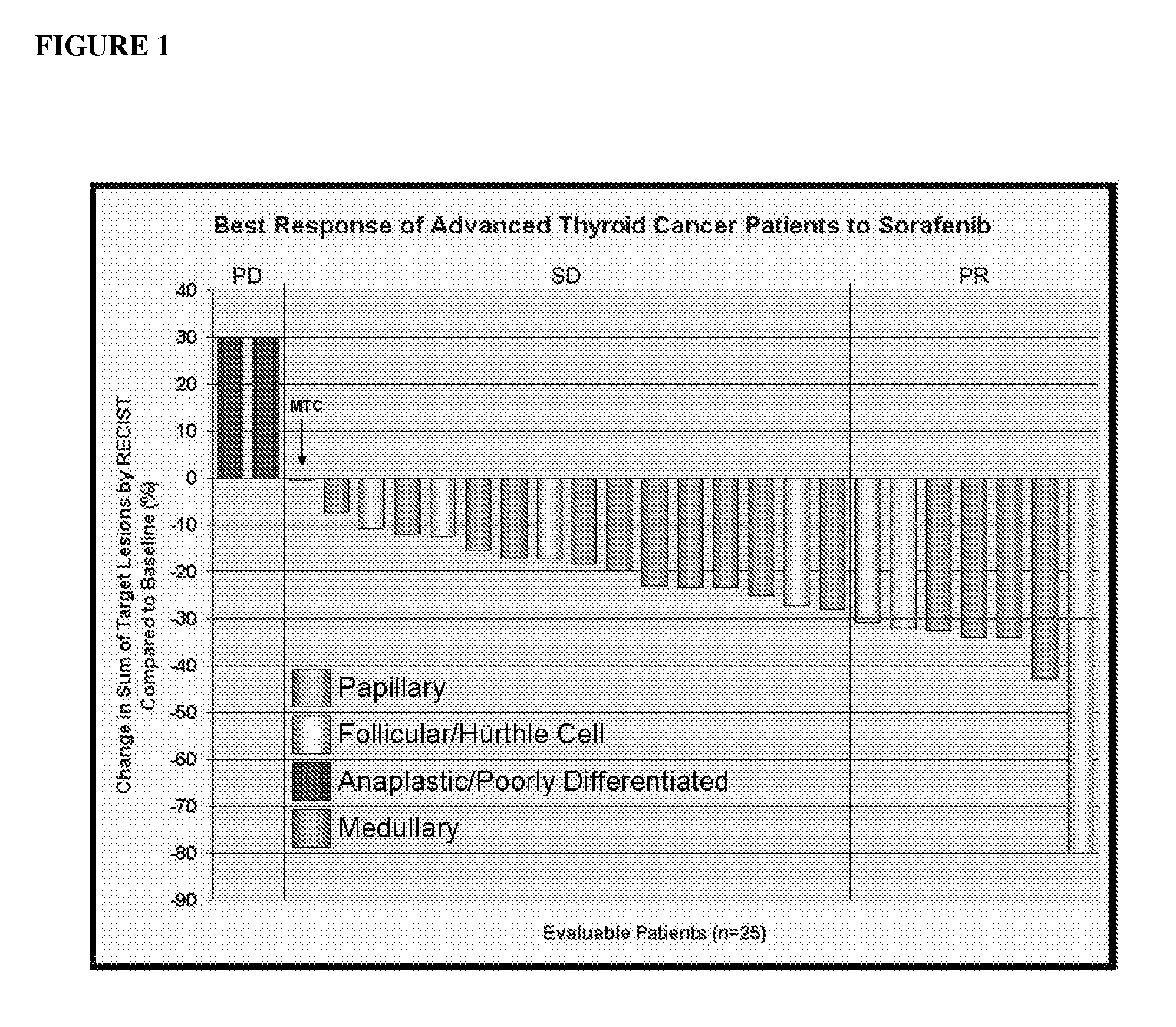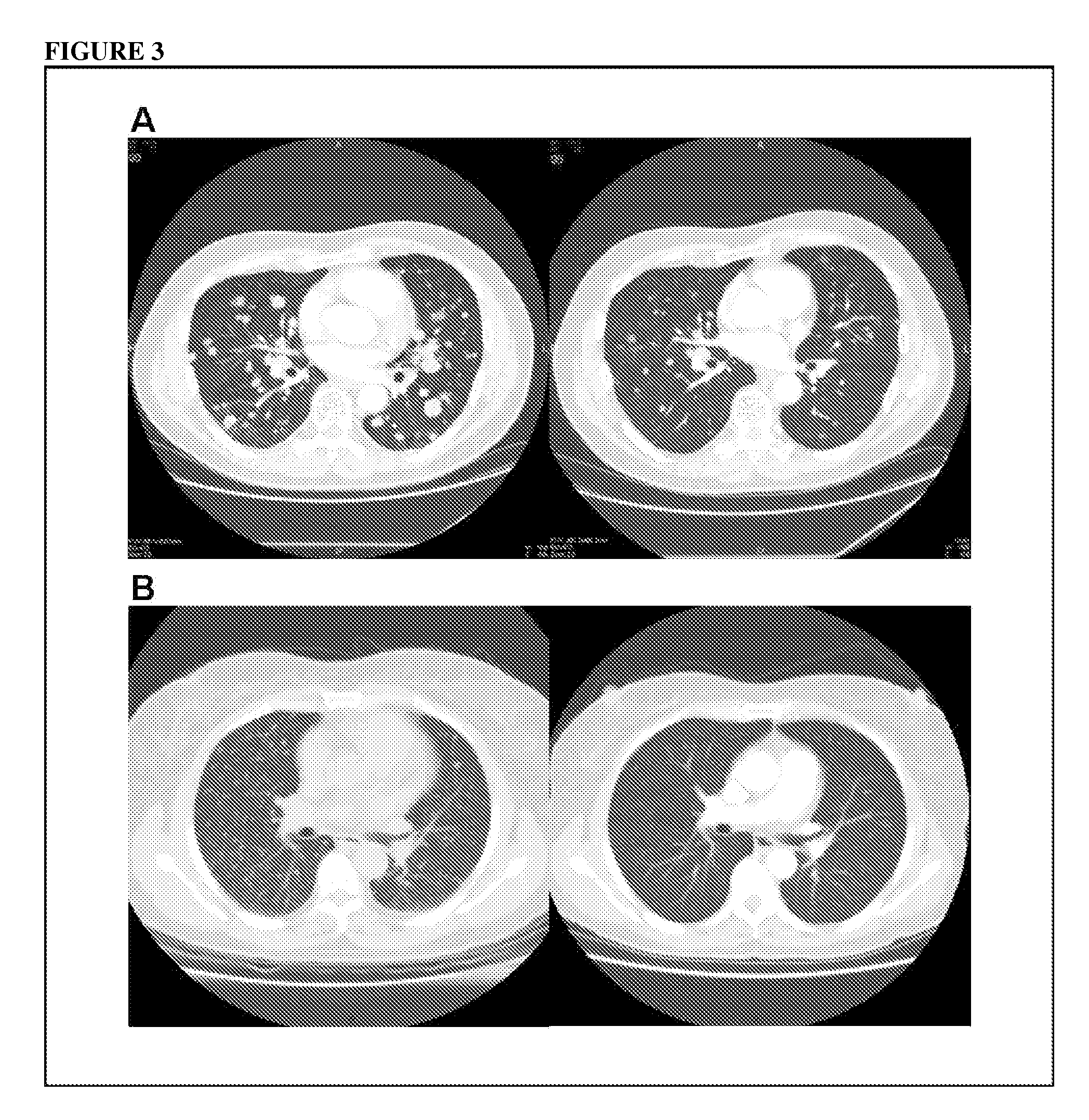Methods for treating thyroid cancer
a thyroid cancer and cancer technology, applied in the field of thyroid cancer treatment, can solve the problems of poor prognosis if metastasis occurs, poor response to all therapies, fast growth of anaplastic tumors, and rapid decline of expected survival, so as to enhance iodine absorption in the thyroid
- Summary
- Abstract
- Description
- Claims
- Application Information
AI Technical Summary
Problems solved by technology
Method used
Image
Examples
example 1
Baseline Characteristics
[0199]Baseline characteristics of the patients entered on study are listed in Table 1; five patients had received prior chemotherapy. No patient was previously treated with a kinase inhibitor. All patients had progressive disease on baseline scans prior to the initiation of treatment and almost all (93%) of the patients had uptake of fluorodeoxyglucose on positron emission tomography (FDG-PET positive).
TABLE 1Baseline Patient CharacteristicsTotal Patients30SexMale15(50%)Female15(50%)Mean Age (years)63Range31-89Baseline Performance Status (ECOG)019(63%)111(37%)Thyroid Cancer SubtypePapillary18(60%)Follicular / Hurthle Cell Variant9(30%)Medullary1(3%)Poorly differentiated / Anaplastic2(7%)Prior Surgery30(100%)Prior I-131 Treatment28(93%)Prior treatment5(17%)Prior chemotherapy3(10%)Prior investigational agents2(7)Prior external beam radiation11(37%)Prior FDG-PETFDG-PET scan completed29(97%)FDG-uptake positive (%)28(93%)
example 2
[0200]The best responses among the 30 patients were assessed (Table 2). This analysis was conducted four months after the last patient started treatment. Twenty-five patients were evaluable for response, but all 30 are included in this intention-to-treat analysis. Responses ranged from progressive disease to a decrease in target lesions of 80% by RECIST criteria (see FIG. 1). The objective partial response rate (defined as decrease in sum of longest diameter measurements>30% by RECIST) for patients on study was 23% (7 patients). The exact binomial 95% confidence interval (CI) of (0.10,0.42) excludes the null hypothesis (p=0.0005). The stable disease rate (defined as change in sum of longest diameter measurements between −30% and +20% by RECIST) was 53% (16 patients; 95% CI (0.34, 0.72)). FIG. 2 shows the Kaplan-Meier curve for all 30 patients; the median overall PFS was 79 weeks. Analysis of differentiated thyroid cancers alone revealed a median PFS of 84 weeks. N...
example 3
Adverse Events
[0210]The median duration of treatment was 27 weeks. Six patients (20%) discontinued treatment due to adverse events. Doses were reduced in 47% (14 patients) to control toxicities. For patients requiring dose reductions, sorafenib was decreased by 25% (to a total 15 dose of 600 mg QD) initially, and 10 patients required up to 50% dose reductions (200 mg BID) for at least one period to control symptoms. Drug “holidays” were required due to adverse events in 63 % of patients (19 patients). The duration of the dose interruptions ranged from one day to two weeks, with one patient requiring a three-week break due to musculoskeletal pain. Doses were interrupted most commonly due to fatigue, palmar / plantar erythema, rash, fatigue, stomatitis / mucositis, weight loss, and musculoskeletal pain.
[0211]Treatment-related adverse events were predominantly of grade 1 or 2, with the most common including palmar / plantar erythema, rash, fatigue, stomatitis / mucositis, weight loss, and mus...
PUM
| Property | Measurement | Unit |
|---|---|---|
| size | aaaaa | aaaaa |
| size | aaaaa | aaaaa |
| radioactive | aaaaa | aaaaa |
Abstract
Description
Claims
Application Information
 Login to View More
Login to View More - R&D
- Intellectual Property
- Life Sciences
- Materials
- Tech Scout
- Unparalleled Data Quality
- Higher Quality Content
- 60% Fewer Hallucinations
Browse by: Latest US Patents, China's latest patents, Technical Efficacy Thesaurus, Application Domain, Technology Topic, Popular Technical Reports.
© 2025 PatSnap. All rights reserved.Legal|Privacy policy|Modern Slavery Act Transparency Statement|Sitemap|About US| Contact US: help@patsnap.com



